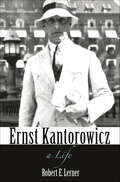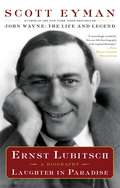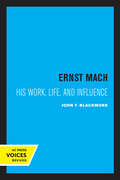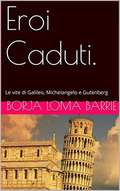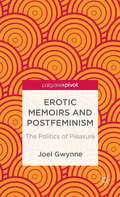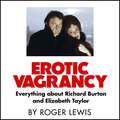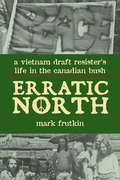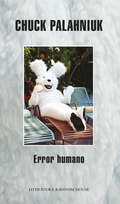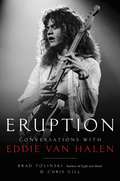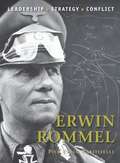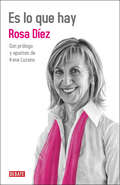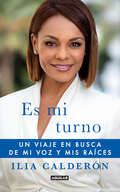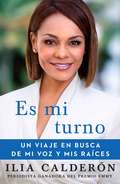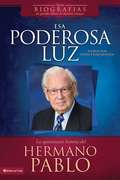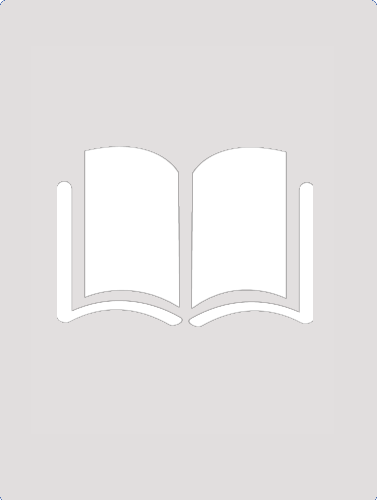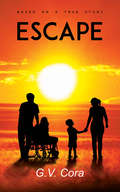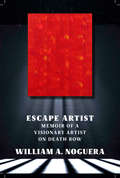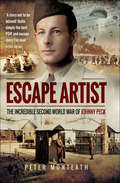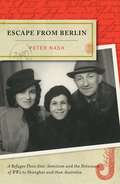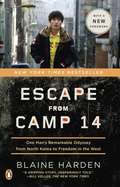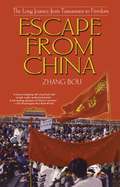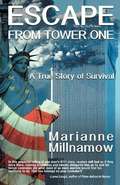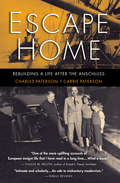- Table View
- List View
Ernst Kantorowicz: A Life
by Robert E. LernerThe first complete biography of an influential historian whose dramatic life intersected with many great events and thinkers of the twentieth centuryThis is the first complete biography of Ernst Kantorowicz (1895–1963), an influential and controversial German-American intellectual whose colorful and dramatic life intersected with many of the great events and thinkers of his time. A medieval historian whose ideas exerted an influence far beyond his field, he is most famous for two books—a notoriously nationalistic 1927 biography of the Holy Roman Emperor Frederick II and The King's Two Bodies (1957), a classic study of medieval politics.Born into a wealthy Prussian-Jewish family, Kantorowicz fought on the Western Front in World War I, was wounded at Verdun, and earned an Iron Cross; later, he earned an Iron Crescent for service in Anatolia before an affair with a general’s mistress led to Kantorowicz being sent home. After the war, he fought against Poles in his native Posen, Spartacists in Berlin, and communists in Munich. An ardent German nationalist during the Weimar period, Kantorowicz became a member of the elitist Stefan George circle, which nurtured a cult of the "Secret Germany." Yet as a professor in Frankfurt after the Nazis came to power, Kantorowicz bravely spoke out against the regime before an overflowing crowd. Narrowly avoiding arrest after Kristallnacht, he fled to England and then the United States, where he joined the faculty at Berkeley, only to be fired in 1950 for refusing to sign an anticommunist “loyalty oath.” From there, he “fell up the ladder” to Princeton’s Institute for Advanced Study, where he stayed until his death.Drawing on many new sources, including numerous interviews and unpublished letters, Robert E. Lerner tells the story of a major intellectual whose life and times were as fascinating as his work.
Ernst Lubitsch: Laughter in Paradise
by Scott Eyman"Highly recommended" (Library Journal): The only full-length biography of legendary film director Ernst Lubitsch, the director of such Hollywood classics as Trouble in Paradise, Ninotchka, and The Shop Around the Corner.In this groundbreaking biography of Ernst Lubitsch, undeniably one of the most important and influential film directors and artists of all time, critic and biographer Scott Eyman, author of the critically acclaimed New York Times bestseller John Wayne, examines not just the films Lubitsch created, but explores as well the life of the man, a life full of both great successes and overwhelming insecurities. The result is a fascinating look at a man and an era--Hollywood's Golden Age. Born in Berlin and transported to Hollywood in the 1920s with the help of Mary Pickford, Lubitsch brought with him a level of sophistication and subtlety previously unknown to American movie audiences. He was quickly established as a director of unique quality and distinction. He captivated audiences with his unique "touch," creating a world of fantasy in which men are tall and handsome (unlike Lubitsch himself) and humorously adept at getting women into bed, and where all the women are beautiful and charming and capable of giving as well as receiving love. He revived the flagging career of Marlene Dietrich and, in Ninotchka, created Greta Garbo's most successful film. When movie buffs speak of "the Lubitsch touch," they refer to a sense of style and taste, humor and humanity that defined the films of one of Hollywood's all-time great directors. In the history of the medium, no one has ever quite equaled his unique talent. Written with the cooperation of an extraordinary ensemble of eyewitnesses, and unprecedented access to the files of Paramount Pictures, this is an enthralling biography as rich and diverse as its subject--sure to please film buffs of all types, especially those who champion Lubitsch as one of the greatest filmmakers ever.
Ernst Mach: His Life, Work, and Influence
by John T. BlackmoreThis title is part of UC Press's Voices Revived program, which commemorates University of California Press’s mission to seek out and cultivate the brightest minds and give them voice, reach, and impact. Drawing on a backlist dating to 1893, Voices Revived makes high-quality, peer-reviewed scholarship accessible once again using print-on-demand technology. This title was originally published in 1972.
Eroi Caduti. Le vite di Galileo, Michelangelo e Gutenberg
by Borja Loma Barrie Anna BennicelliRomanzo storico. Le vite dell'astronomo perseguitato dall'Inquisizione, dell'artista autore della Cappella Sistina tormentato dai demoni interiori e del pover'uomo che inventò la stampa e che con questa voleva diventare ricco.
Erotic Memoirs and Postfeminism: The Politics of Pleasure
by Joel GwynneThis book analyses the impact of postfeminist discourse and the mainstreaming of pornography on our understanding of intimacy and female sexuality. It is a broad critical survey of a recent publishing phenomenon - the female-authored erotic memoir - and positions the texts under analysis as complex and contradictory expressions of popular feminism.
Erotic Vagrancy: Everything about Richard Burton and Elizabeth Taylor
by Roger LewisThe comic genius of English writing takes on Hollywood, delusion, celebrity and last century's ultimate glamour couple: Richard Burton and Elizabeth Taylor.Richard Burton and Elizabeth Taylor were a Sixties supercharged couple in an era of supercharged couples. As a pairing they were fantasy figures, impossibly desirable. Liz supple and soft, in perfumes and furs - yet with something demonic and lethal about her. Dick, in turn, with his ravaged, handsome face, looked as though lit by silver moonlight - poised to turn into a wolf.Roger Lewis uses this glamorous and damaged pair as the starting point to tell the story of an age of excess: the freaks and groupies, the private jets and jewels and the yachts sailing in an azure sea; the magnificent bad taste and greed. It is about the clash of worlds: the filth and decay of South Wales and the grandeur and elegance of Old Hollywood; the fantasies we have about film stars and the fantasies the Burtons had about each other.'Brilliantly funny . . . the book of the year' - Sunday Times'By turns, funny, tragic, tender and vicious . . . a word-of-mouth sensation' - Guardian(P) 2023 Quercus Editions Ltd
Erotic Vagrancy: Everything about Richard Burton and Elizabeth Taylor
by Roger Lewis'One of the very best biographies I have ever read' STEPHEN FRY'A hot thunderstorm of a book' DAVID HARE'Erotic Vagrancy gave me a week of pure joy' CRAIG BROWN'Unputdownable' TONY PALMER'A genius writer' LYNN BARBERRichard Burton and Elizabeth Taylor were a Sixties supercharged couple in an era of supercharged couples. As a pairing they were fantasy figures, impossibly desirable. Liz supple and soft, in perfumes and furs - yet with something demonic and lethal about her. Dick, in turn, with his ravaged, handsome face, looked as though lit by silver moonlight - poised to turn into a wolf. Roger Lewis uses this glamorous and damaged pair as the starting point to tell the story of an age of excess: the freaks and groupies, the private jets and jewels and the yachts sailing in an azure sea; the magnificent bad taste and greed. It is about the clash of worlds: the filth and decay of South Wales and the grandeur and elegance of Old Hollywood; the fantasies we have about film stars and the fantasies the Burtons had about each other.
Erotic Vagrancy: Everything about Richard Burton and Elizabeth Taylor
by Roger Lewis'One of the very best biographies I have ever read' STEPHEN FRY'A hot thunderstorm of a book' DAVID HARE'Erotic Vagrancy gave me a week of pure joy' CRAIG BROWN'Unputdownable' TONY PALMER'A genius writer' LYNN BARBERRichard Burton and Elizabeth Taylor were a Sixties supercharged couple in an era of supercharged couples. As a pairing they were fantasy figures, impossibly desirable. Liz supple and soft, in perfumes and furs - yet with something demonic and lethal about her. Dick, in turn, with his ravaged, handsome face, looked as though lit by silver moonlight - poised to turn into a wolf. Roger Lewis uses this glamorous and damaged pair as the starting point to tell the story of an age of excess: the freaks and groupies, the private jets and jewels and the yachts sailing in an azure sea; the magnificent bad taste and greed. It is about the clash of worlds: the filth and decay of South Wales and the grandeur and elegance of Old Hollywood; the fantasies we have about film stars and the fantasies the Burtons had about each other.
Erratic North: A Vietnam Draft Resister's Life in the Canadian Bush
by Mark FrutkinIn geology an erratic is a "boulder or rock formation transported some distance from its original source, as by a glacier." In award-winning novelist Mark Frutkin’s case, his movement from his native Cleveland. Ohio, was instigated by his wish to protest and resist the U.S. military draft during the Vietnam War, and his destination was Canada.An estimated 50,000 to 100,000 American Vietnam War draft resisters sought sanctuary in Canada. Many of these men stayed, became Canadian citizens, and have made significant contributions to the country, including writers such as William Gibson, George Fetherling, Keith Maillard, and Jay Scott; musicians Jesse Winchester and Jim Byrnes; children’s performer Eric Nagler; and radio personality Andy Barrie.Although this first nonfiction work by Mark Frutkin looks back at the circumstances and culture of the late 1960s and early 1970s that prompted the author to relocate to Canada, Erratic Northis about many other things. It’s also a lyrical meditation about "returning to nature" in the bush country of Quebec and an account of the crucible that forged one writer. Tying everything together, though, is the overarching theme of the book: a contemplation of humanity’s embrace of war and violence and the countervailing impulse to resist that embrace, specifically as seen in the experience of Frutkin himself; his grandfather Simon, who escaped Tsarist Russia and its military in the 1890s; and Louis Drouin, the Quebec farmer Frutkin bought his original farm from and who resisted conscription in World War II.
Error humano
by Chuck PalahniukUna antología de crónicas, retratos e historias por el autor de El club de la lucha Compendio de crónicas, retratos de estrellas e historias íntimas, Error humano nos permite entrever el insólito mundo del autor y nos invita a destapar algunas de las realidades más sórdidas que alimentan sus novelas. Destacan en este universo el capítulo "Combate de cosechadoras", una crónica sobre la América profunda donde se mezclan el absurdo y la aberración, el retrato de un Marilyn Manson que habla sin tapujos de sí mismo a través de una sesión de tarot o la curiosa descripción del rodaje de El club de la lucha, en la que se habla del potenciador de labios de Brad Pitt. Reseñas: «Tal vez nuestra generación haya encontrado otro Don DeLillo.» Bret Easton Ellis «Como Edgar Allan Poe, Palahniuk es un incansable proveedor tóxico de un creciente horror. En su caso, convierte el nihilismo en diversión.» Henry Alford, Vanity Fair «Palahniuk siempre ha dicho que sus libros son mera observación y, cuando uno lee sobre los lugares a los que va y la gente a la que conoce, es fácil creerlo.» Alice Fisher, Time Out London
Eruption: Conversations with Eddie Van Halen
by Brad Tolinski Chris GillGet a completely new look at guitar legend Eddie Van Halen with this groundbreaking oral history, composed of more than fifty hours of interviews with Eddie himself as well as his family, friends, and colleagues. When rock legend Eddie Van Halen died of cancer on October 6, 2020, the entire world seemed to stop and grieve. Since his band Van Halen burst onto the scene with their self-titled debut album in 1978, Eddie had been hailed as an icon not only to fans of rock music and heavy metal, but to performers across all genres and around the world. Van Halen&’s debut sounded unlike anything that listeners had heard before and remains a quintessential rock album of the era. Over the course of more than four decades, Eddie gained renown for his innovative guitar playing, and particularly for popularizing the tapping guitar solo technique. Unfortunately for Eddie and his legions of fans, he died before he was ever able to put his life down to paper in his own words, and much of his compelling backstory has remained elusive—until now. In Eruption, music journalists Brad Tolinski and Chris Gill share with fans, new and old alike, a candid, compulsively readable, and definitive oral history of the most influential rock guitarist since Jimi Hendrix. It is based on more than 50+ hours of unreleased interviews they recorded with Eddie Van Halen over the years, most of them conducted at the legendary 5150 studios at Ed&’s home in Los Angeles. The heart of Eruption is drawn from these intimate and wide-ranging talks, as well as conversations with family, friends, and colleagues. In addition to discussing his greatest triumphs as a groundbreaking musician, including an unprecedented dive into Van Halen&’s masterpiece 1984, the book also takes an unflinching look at Edward&’s early struggles as young Dutch immigrant unable to speak the English language, which resulted in lifelong issues with social anxiety and substance abuse. Eruption: Conversations with Eddie Van Halen also examines his brilliance as an inventor who changed the face of guitar manufacturing.As entertaining as it is revealing, Eruption is the closest readers will ever get to hearing Eddie&’s side of the story when it comes to his extraordinary life.
Erwin Rommel: Leadership, Strategy, Conflict
by Pier Paolo BattistelliA short biography of General field marshal Erwin Rommel, the legendary 'Desert Fox', who ranks amongst the most famous generals of World War II. A daring infantry officer during World War I, in the early months of World War II Rommel took over command of a Panzer division, which he led in one of the most crucial areas of the German offensive in the West. It was as commander of the Afrikakorps from 1941 that he fought his most famous battles and came close to driving the British out of Egypt. Defeated by Montgomery at El Alamein, he later led the German forces during the battle for Normandy in 1944, but after being implicated in the plot against Hitler, he was forced to commit suicide. Lionized by British historians of the post-war period as representing all that was good in the German military tradition, this title re-assesses his role as a battlefield commander, analysing his strengths and weaknesses.
Es lo que hay
by Irene LozanoUn recorrido de Rosa Díez por los temas candentes de la actualidad y su ideario político. El político mejor valorado de España es una política: Rosa Díez. Las encuestas no precisan el porqué de ese aprecio ciudadano, aunque no resulta difícil aventurar que sus cualidades han quedado de manifiesto en momentos cruciales de la reciente vida política española: su coraje, en la lucha contra el terrorismo y el nacionalismo obligatorio; su coherencia, como disidente del PSOE; la fuerza de sus convicciones, en el proyecto colectivo de UPyD; su sinceridad, en el desempeño como diputada. La labor de Rosa Díez no ha contado con la fabulosa maquinaria propagandística de un gran partido, ni con el favor de los bancos -que se negaron a financiar a UPyD en su nacimiento-, ni con la complicidad de medios de comunicación amigos. De ahí que se haya acostumbrado a hacer política dirigiéndose a la gente sin intermediarios. En este libro, una suerte de diario político, escrito entre la urgencia cotidiana y la tranquilidad de saber que la siembra de ideas siempre se recoge años después, Rosa Díez sale una vez más al encuentro de los ciudadanos: los interesados en su pensamiento y los escépticos, los admiradores y los detractores, los ilusionados con sus aspiraciones y los que temen albergar esperanzas respecto a la política. Habrá a quien no le guste, pero es lo que hay.
Es mi turno: Un viaje en busca de mi voz y mis raíces
by Ilia CalderonLAS MEMORIAS INSPIRADORAS, PERTINENTES Y PROVOCADORAS DE ILIA CALDERÓN -LA PRIMERA PRESENTADORA AFROLATINA EN UN NOTICIARIO HISPANO DE PREEMINENCIA EN LOS ESTADOS UNIDOS- ACERCA DE SEGUIR SUS SUEÑOS, SUPERAR PREJUICIOS Y ACOGER SU IDENTIDAD. De niña, Ilia Calderón se sentía como una típica niña colombiana. En el Chocó, la provincia afrolatina donde se crio, tu piel podría ser de cualquier tono y aún serías considerado familia. Pero cuando dejó su comunidad para asistir a la escuela secundaria y la universidad en Medellín, todo cambió. A partir de ese momento, resolvió volverse "sorda" al racismo, decidida a superar el prejuicio, incluso cuando le repetían que los trabajos prominentes de presentador de noticias no eran para ella. Cuando un giro del destino le presentó una oportunidad única en la cadena noticiera Telemundo en Miami, estaba emocionada de comenzar una nueva vida -e identidad- en los Estados Unidos, donde las fronteras raciales, creía, se habían disuelto hace mucho tiempo y la igualdad era la regla. Sin embargo, se enfrentó a otro tipo de discriminación racial como una mujer inmigrante de color que le hablaba en español a la comunidad latina cada vez más marginada. En los últimos nueve años, Ilia ha reportado desde la primera línea de eventos históricos como el huracán Katrina, los terremotos en México, las elecciones presidenciales de los Estados Unidos de 2016 y la crisis pandémica del COVID-19. Ahora, Ilia corre el telón de los altibajos de su extraordinaria vida y carrera. Desde luchas internas personales hasta problemas profesionales analiza cómo construyó su identidad en medio de la violencia con carga de motivos raciales y la polarización política. Sobre la marcha, ella muestra cómo ha superado el miedo y enfrentado el odio de cara a cara, todo en nombre de crear un mundo mejor para su joven hija, Anna. "Existen muy pocas historias de superación que se acerquen siquiera a las de Ilia como madre y periodista. Qué suerte la mía de trabajar con ella y ser testigo de esta mujer cambiando al mundo."-Jorge Ramos, presentador principal de Noticiero Univision "Esta es la historia de una niñita quién creció con grandes carencias en una humilde casa de madera, que se inundaba cada vez que el río crecía, y quién aprendió a luchar y prepararse para llegar a ser la primera afrolatina en el noticiero más importante en la televisión en español de los EE. UU. La lección que Ilia Calderón aquí nos enseña es clara: ¡todo se puede!" -María Antonieta Collins, autora de bestsellers y corresponsal principal de Noticiero Univisión
Es mi turno: Un viaje en busca de mi voz y mis raíces (Atria Espanol)
by Ilia CalderónLas memorias inspiradoras, pertinentes y provocadoras de Ilia Calderón—la primera presentadora afrolatina en un noticiario hispano de preeminencia en los Estados Unidos—acerca de seguir sus sueños, superar prejuicios y acoger su identidad.De niña, Ilia Calderón se sentía como una típica niña colombiana. En el Chocó, la provincia afrolatina donde se crio, tu piel podría ser de cualquier tono y aún serías considerado familia. Pero cuando dejó su comunidad para asistir a la escuela secundaria y la universidad en Medellín, todo cambió. A partir de ese momento, resolvió volverse &“sorda&” al racismo, decidida a superar el prejuicio, incluso cuando le repetían que los trabajos prominentes de presentador de noticias no eran para ella. Cuando un giro del destino le presentó una oportunidad única en la cadena noticiera Telemundo en Miami, estaba emocionada de comenzar una nueva vida —e identidad— en los Estados Unidos, donde las fronteras raciales, creía, se habían disuelto hace mucho tiempo y la igualdad era la regla. Sin embargo, se enfrentó a otro tipo de discriminación racial como una mujer inmigrante de color que le hablaba en español a la comunidad latinx cada vez más marginada. En los últimos nueve años, Ilia ha reportado desde la primera línea de eventos históricos como el huracán Katrina, los terremotos en México, las elecciones presidenciales de los Estados Unidos de 2016 y la crisis pandémica del COVID-19. Ahora, Ilia corre el telón de los altibajos de su extraordinaria vida y carrera. Desde luchas internas personales hasta problemas profesionales analiza cómo construyó su identidad en medio de la violencia con carga de motivos raciales y la polarización política. Sobre la marcha, ella muestra cómo ha superado el miedo y enfrentado el odio de cara a cara, todo en nombre de crear un mundo mejor para su joven hija, Anna.
Esa poderosa luz: La apasionante historia del Hermano Pablo
by Linda FinkenbinderEn este libro se plasma la vida del Hermano Pablo. Es en sí la historia de cómo Dios ha usado una vida consagrada a él para llevar la luz del evangelio al mundo. Su ejemplo, sencillez y testimonio dicen realmente del amor que siente por su Señor, al que ha servido durante toda su vida con amor y entrega total.
Esaú e Jacó
by Machado De Assis"Esaú e Jacó" from Machado de Assis. Escritor brasileiro, amplamente considerado como o maior nome da literatura nacional (1839-1908).
Escape
by G. V. CoraESCAPE… is a historical recounting of one unique family's journey of strength and love across four generations. When the Second World War crossed Romania's borders, the changes were drastic and disorienting, transitioning from a monarchy to Communism, from a "good life" to poverty while moving through a range of emotions from love to the heavy burden of lost hope, to being asked to give up your child because of her physical handicap and, ultimately, to achieving independence. This book will take you through all the struggles, tears, and pain from the dark hell of lost love, unexpected sacrifices, and a regime that nearly suffocated a once beautiful country hanging like a dark shadow above all. Come and share the journey one family took to reach the light, to survive, and succeed.
Escape Artist: A Memoir Of An Artist On Death Row
by William A. NogueraAn ABA Indies Introduce Top Ten Title for Winter 2018William A. Noguera has spent thirty-four years at the notorious San Quentin Prison, home to the nation’s largest and deadliest death row. Each day, men plot against you and your life rests on a razor’s edge. In Escape Artist, he describes his personal growth as a man and artist and shares his insights into daily life and the fight to survive in the underworld of prison culture. After being sentenced to death, he arrived at San Quentin Prison and was thrown into a rat-infested cell—it was there that he discovered the key to his escape: art. Over the next three decades, Noguera rebelled against conventional prison behavior, and instead forged the code he lives by today—accepting responsibility for his actions, and a self-imposed discipline of rehabilitation. In the process, he has explored his capacity to bring focus and clarity to his artistic vision. Escape Artist exposes the violence, politics and everyday existence within the underbelly of society that is prison life. In an unprecedented narrative, Noguera reveals the emotional and heart-wrenching loss that landed him on death row and the journey he has taken to become an award-winning artist, speaker, and author—a tale of one man’s transformation through tragedy.
Escape Artist: The Incredible Second World War of Johnny Peck
by Peter MonteathThe never-before-told story of World War II escape artist extraordinaire, Johnny Peck.In August 1941, an eighteen-year-old Australian soldier made his first prison break an audacious night-time escape from a German prisoner-of-war camp in Crete. Astoundingly, this was only the first of many escapes.An infantryman in the 2/7 Battalion, Johnny Peck was first thrown into battle against Italian forces in the Western Desert. Campaigns against Hitlers Wehrmacht and Luftwaffe in Greece and Crete followed. When Crete fell to the Germans at the end of May 1941, Peck was trapped on the island with hundreds of other men. On the run, they depended on their wits, the kindness of strangers, and sheer good luck.When Pecks luck ran out, he was taken captive by the Germans, then the Italians. Later, after his release from a Piedmontese jail following the Italian Armistice of 1943, and at immense risk to his own life, Peck devoted himself to helping POWs cross the Alps to safety. Captured once more, Peck was sentenced to death and detained in Milans notorious, Gestapo-run San Vittore prison until escaping again, this time into Switzerland.Historian Peter Monteath reveals the action-packed tale of one young Australian soldier and his remarkable war.
Escape From Berlin
by Peter NashA Holocaust survivor tells his compelling family story of escape and survival in China and Australia during WW2. Living in Berlin in 1939, three-year-old Peter Nachemstein and his parents were forced to escape Nazi Germany by fleeing to Shanghai – one of the only havens left for them and 18,000 other European Jews. Although safe, they became displaced and isolated from the rest of their family, who were scattered across Europe. In Escape from Berlin, Peter Nash retraces what became of his family members following the devastating impact of WW2. Using remarkable photographs and documents to bring their captivating stories to life, Peter recounts his own experiences of dislocation as a young boy in alien Shanghai, and then later as a teenager and adult in Australia. Meticulously researched and impeccably detailed, Escape from Berlin brings light to a fascinating but not widely known chapter of Holocaust history in a family story that reflects the experiences of many in the Jewish community.
Escape From Camp 14: One Man's Remarkable Odyssey from North Korea to Freedom in the West
by Blaine HardenThe heart-wrenching New York Times bestseller about the only known person born inside a North Korean prison camp to have escaped North Korea's political prison camps have existed twice as long as Stalin's Soviet gulags and twelve times as long as the Nazi concentration camps. No one born and raised in these camps is known to have escaped. No one, that is, except Shin Dong-hyuk. In Escape From Camp 14, Blaine Harden unlocks the secrets of the world's most repressive totalitarian state through the story of Shin's shocking imprisonment and his astounding getaway. Shin knew nothing of civilized existence--he saw his mother as a competitor for food, guards raised him to be a snitch, and he witnessed the execution of his mother and brother. The late "Dear Leader" Kim Jong Il was recognized throughout the world, but his country remains sealed as his third son and chosen heir, Kim Jong Eun, consolidates power. Few foreigners are allowed in, and few North Koreans are able to leave. North Korea is hungry, bankrupt, and armed with nuclear weapons. It is also a human rights catastrophe. Between 150,000 and 200,000 people work as slaves in its political prison camps. These camps are clearly visible in satellite photographs, yet North Korea's government denies they exist. Harden's harrowing narrative exposes this hidden dystopia, focusing on an extraordinary young man who came of age inside the highest security prison in the highest security state. Escape from Camp 14 offers an unequalled inside account of one of the world's darkest nations. It is a tale of endurance and courage, survival and hope.
Escape From China
by Zhang BoliWho can forget the searing images, telecast around the world, of the brave Chinese students facing the tanks that rolled toward them in Tiananmen Square as they rebelled against their Communist government? After a two-week standoff, the military forces charged in and brutally suppressed the revolt, killing many students and issuing a warrant for the arrest of all responsible for the insurgence. As one of the top student leaders in the demonstrations at Tiananmen Square, Zhang Boli became even more famous as he managed to evade a ruthless nationwide police manhunt. After two years as a fugitive, he was the only leader who had not been accounted for. Among the twenty-one students placed on the government's most-wanted list, Zhang knew that he would never again be able to live openly in China and that he must bid his beloved country -- as well as his wife and baby daughter -- farewell. In Escape From China, Zhang Boli tells the fascinating, inspirational story of how he avoided capture and surpassed overwhelming obstacles in his struggle to survive and ultimately find freedom in the West. Traveling across the frozen terrain of the former Soviet Union, where Russian peasants rescued him, and finding his way through the deserted lands of China's precarious borders, Zhang had little but his extraordinary will to propel him, subsisting for months at a time on the flesh of wild animals. In the course of his long ordeal, he loses his love, finding God and, eventually, freedom. Although Zhang's incredible journey was filled with many harrowing experiences, he chooses, in this gripping first-person account, to focus on the many kind people who helped him through his darkest days. A powerful memoir of great drama and historical resonance, Escape From China will not only astound you, but renew your faith in humanity and in the power of the human spirit.
Escape From Tower One: The True Story of How Vincent Borst Survived the 9/11 Attack on the World Trade Center and Led Others to Safety From the 82nd Floor of the North Tower
by Marianne MillnamowThe true story of Vinnie Borst, an employee of the Port Authority, who survived the 9/11 Attack on the World Trade Center and led others to safety from the 82nd floor of the North Tower. A compelling account of one man's heroic actions in the face of tragedy. A third of the proceeds from the sale of this book will go to two funds: the Edward T. Strauss Memorial Fund (www. WithEddiesHelp. org) to assist those with disabilities and combat homelessness AND the Aspiring Kindness Foundation, a 501(c)(3) not-for-profit public corporation that provides financial assistance to support and enhance the abilities of emergency responders and service providers (www. aspiringkindness. org).
Escape Home
by Charles Paterson Carrie Paterson"Intimate and scholarly. . . Patient readers will be rewarded. An encyclopedic and epistolary family history, a eulogy for pre-Reich Vienna and an ode to midcentury modernism. ” --Kirkus Reviews "This jewel should not be called a book but a museum. ” -- Will Semler, author (Melbourne, Australia) "One of the more uplifting accounts of European #65533;migr#65533; life that I have read in a long time. . . . It will touch you to tears right away, regardless of how many accounts of similar fates you believe to have studied and understood. . . . What a book!" -- Volker M. Welter, author and architectural historian "An invaluable addition to the literature on the birth of modern Aspen. " --Stewart Oksenhorn,The Aspen Times Charles Paterson (born Karl Schanzer) was only nine years old when the Nazis invaded Austria and his father, Stefan, fled with his children to avoid persecution. To assure their continued safety, the children were baptized and adopted by the Paterson family in Australia while Stefan made a harrowing escape through occupied France. It would be eight years, after much sorrow and loss, before Charles and his sister would reunite with Stefan in the United States. After Charles and Stefan settle in Aspen, Colorado, amidst the snow-capped peaks that remind them of the Austrian Alps, Stefan becomes a high school teacher known for his humor and adventure stories while Charles teaches skiing, serves as a Frank Lloyd Wright apprentice, and then builds his thesis project, the The Boomerang ski lodge. Charles lives with Stefan at The Boomerang and, as Aspen grows into a world-class ski resort, spends fifty years welcoming thousands of people to the town withAustrian warmth andgem#65533;tlichkeit. Based on archival documents and letters, together with the authors’ personal reflections,Escape Home is a family memoir and a meditation on the domestic qualities of architecture, where the bonds of culture and family prove to be the true foundation for rebuilding meaningful lives and finding both security and freedom.
